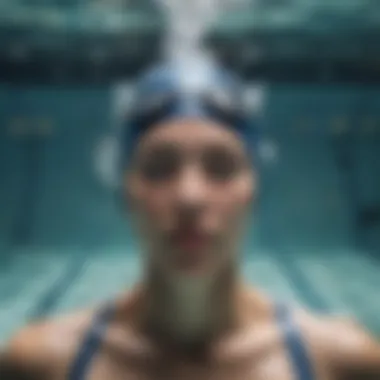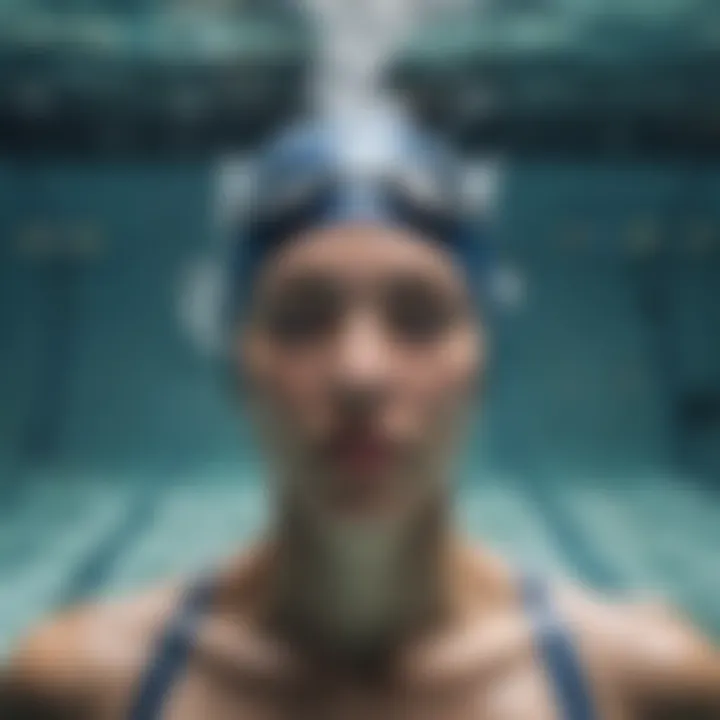Boosting Lung Capacity for Superior Swimming Performance


Intro
As swimming enthusiasts know, the ability to take in and utilize more oxygen can greatly impact performance in the pool or ocean. For those keen on elevating their game, enhancing lung capacity isn't just a bonus—it's almost a necessity. The art of breathing effectively while swimming can mean the difference between a comfortable glide and gasping for air. Therefore, diving deep into methods for improving lung capacity is crucial, not just to extend endurance but also to boost overall efficiency in the water.
Understanding the physiological mechanisms behind breath control is essential. Swimmers can maximize their lung's potential through both targeted exercises and mindful breathing techniques. This guide will explore multiple aspects of lung capacity enhancement, providing actionable strategies that cater to both beginners and seasoned athletes. It's not just about the strokes you make but also about how well you can breathe while making them.
Gear Essentials
When it comes to boosting your lung capacity, having the right gear can play an essential role. While you might think that swimming is all about the swimsuit and goggles, specialized equipment can actually enhance your breathing practices.
Top Picks for Watersports Equipment
- Breath Training Masks: Designed to simulate high-altitude training, these masks help train your respiratory muscles by restricting airflow. They can be a game changer for swimmers looking to push their limits.
- Snorkels: A snorkel can be used to practice controlled breathing without the interruptions of turning your head to breathe. This device allows for sustained practice that builds lung capacity and improves overall stroke efficiency.
- Resistance Bands: Using these bands while swimming can increase the load on your lungs during workouts. Incorporating resistance training helps improve both strength and capacity over time.
- Hydration Packs: Staying hydrated is vital for lung function. A proper hydration pack can ensure you’re getting the fluids needed to maintain optimal performance, especially during longer swim sessions.
Maintenance and Care Tips for Gear
To maximize the lifespan and efficiency of your equipment, follow these care tips:
- Rinse gear with fresh water after each use to remove perspiratiion and salt.
- Store items in a dry, shaded area to prevent damage from UV rays.
- Regularly check for any wear or tear, especially in training masks and snorkels.
Taking care of your gear not only enhances performance but also ensures safety in the water. Proper maintenance means you can rely on your equipment, knowing it won’t fail when you need it the most.
Techniques and Tips
Focusing on key techniques and learning how to harness your breath can significantly enhance your swimming experience and performance.
Beginner Tips for Each Watersport
- Start with Breathing Drills: Practice breathing exercises on land first. Take deep breaths, hold for a second, then exhale slowly. Repeat.
- Incorporate Floatation Devices: Use kickboards or pull buoys to focus on breath control without worrying about strokes or positioning.
Advanced Techniques for Skill Enhancement
- Interval Training: Swim short bursts at high intensity, emphasizing breath control during recovery periods. This builds both stamina and lung capacity over time.
- Mindfulness Practices: Incorporate yoga or pilates that emphasize deep breathing and lung expansion. These techniques can enhance awareness of your breath while swimming.
"Training your lungs is like tuning an engine. The more precise you are, the smoother the ride will be."
By implementing the insights from this guide, swimmers, paddleboarders, and kitesurfers can embark on a path toward improved breathing techniques and enhanced lung capacity. This not only refines performance but enhances the overall experience in the water, transforming every stroke into a more powerful expression of skill.
Understanding Lung Capacity
Lung capacity plays a pivotal role in swimming performance, as it directly influences an athlete's ability to sustain physical exertion and manage breath control under water. Understanding this intricacy not only helps swimmers optimize their training but also allows them to recognize how various factors affect their respiratory efficiency. This section aims to dissect the elements that define lung capacity and illustrate their significance in pool or open water contexts.
Definition of Lung Capacity
Lung capacity refers to the total volume of air that the lungs can hold. It encompasses several components, particularly tidal volume, inspiratory reserve volume, and expiratory reserve volume. When a swimmer talks about their lung capacity, they are often referring to how much air they can breathe in and out during their workouts or races. To put it simply, the more air a swimmer can take in, the longer they can exert themselves without becoming winded.
Anatomy of the Respiratory System
Understanding the anatomy of the respiratory system is crucial when exploring lung capacity. The lungs, divided into lobes, are primarily where gas exchange takes place. The diaphragm, a dome-shaped muscle lying beneath the lungs, plays a key role in the breathing process. When the diaphragm contracts, it pulls down, allowing the lungs to expand and draw in air. This expansion is critical for swimmers who require a high volume of air to support their aerobic demands.
Additionally, the bronchi and bronchioles facilitate the passage of air to the alveoli, the tiny air sacs where oxygen and carbon dioxide are exchanged with the bloodstream. A thorough comprehension of this anatomy helps swimmers appreciate why effective breathing techniques are fundamental to their performance.
Factors Influencing Lung Capacity
Several factors can influence lung capacity, both positively and negatively, impacting a swimmer's performance. These include:
- Age: As people age, their lung capacity generally decreases, which could affect older swimmers during prolonged physical activity.
- Fitness Level: Regular exercise, particularly aerobic training, can enhance lung capacity by improving respiratory muscle strength and endurance.
- Altitude: Training at higher altitudes, where oxygen levels are lower, can lead to adaptations that increase lung capacity.
- Health Conditions: Conditions such as asthma or chronic obstructive pulmonary disease can significantly hinder lung function, making it challenging for swimmers to maintain optimal performance.
- Smoking: The impact of smoking on lung function is well-documented, and eliminating this habit can lead to better overall lung health.
"Lung capacity isn't just about the air you can take in; it reflects your overall physical condition and readiness to tackle the water."
Understanding these factors adds depth to a swimmer's training regimen, revealing that enhancing lung capacity goes beyond the water and into lifestyle choices and health practices. By grasping the essence of lung capacity, swimmers can better tailor their training and strategic approaches to breathe more efficiently, boosting their performance in the water.


The Role of Lung Capacity in Swimming
Lung capacity plays a pivotal role in swimming performance. For swimmers, the ability to efficiently intake oxygen and expel carbon dioxide translates directly into improved speed, endurance, and overall efficiency in the water. Swimmers who grasp the intricacies of lung function find themselves able to maintain their pace longer, turning short, breathless swims into long, fluid strokes. This becomes increasingly important when considering the physical exertion required during various strokes and race lengths.
When you're swimming, your body works hard, demanding ample oxygen, which fuels your muscles. If you don’t have the lung capacity to deliver enough oxygen to your muscles, fatigue will set in like a storm cloud rolling in on a sunny day.
Breath Control and Swimming Efficiency
Breath control is not simply a technique, but a science that can elevate a swimmer’s performance. Properly timed inhalations and exhalations ensure that oxygen is plentiful while keeping the stroke smooth and unbroken. The rhythm of breathing must align seamlessly with stroke mechanics, creating a harmonious flow instead of a chaotic struggle for air.
Consider the 200-meter freestyle: here, each breath should feel instinctual rather than forced. Swimmers often practice bilateral breathing. This means taking breaths on both sides, allowing for better stroke symmetry and reducing the risk of muscle imbalances.
A few techniques that can aid in breath control include:
- Inhale deeply before hitting the water: Filling up the lungs can set a good base for the swim.
- Focus on exhaling underwater: This clears carbon dioxide buildup without interrupting the rhythm of the stroke.
- Practice quick, short breaths: This can help during high-intensity sets where oxygen demands peak.
Impact on Endurance and Speed
Maximizing lung capacity has a profound impact on endurance and speed. Swimmers with higher lung volumes can sustain their performance over longer periods. It’s akin to having a larger fuel tank; more oxygen availability means you can swim longer distances without tiring out too quickly.
Research indicates that an increase in lung capacity allows for increased minute ventilation. This means swimmers can breathe more air per minute, directly contributing to a more efficient swim.
Moreover, optimal lung function leads to reduced drag. When breathing is controlled and efficient, swimmers maintain a better streamlined position in the water. This is not just a trivial detail – it’s crucial for improving speed.
There’s also a correlation between lung capacity and anaerobic performance. Greater lung capacity can help in clearing lactate more efficiently, thus allowing swimmers to recover faster during training sessions. The less time taken to recover, the more time there is to train.
The link between lung capacity and swimming prowess should encourage any athlete to incorporate targeted breathing exercises into their training regimens.
In summary, recognizing the role lung capacity plays in swimming is essential for any serious swimmer. Breath control impacts swimming efficiency, while overall lung capacity enhances endurance and speed, making the understanding and improvement of lung function a focal point for achieving betteer performance in the water.
Techniques for Increasing Lung Capacity
Enhancing lung capacity is crucial for swimmers striving to elevate their performance. Improved lung capacity directly correlates to better breath control, which is an essential component of swimming efficiency. In a sport where each second counts, being able to maximize oxygen intake and minimize wasted breaths can be the difference between winning and merely participating. Additionally, various breathing techniques offer benefits that extend beyond the pool, impacting daily activities and overall health. This section discusses several effective techniques that are particularly beneficial for those looking to make strides in their lung capacity, specifically designed for athletes.
Diaphragmatic Breathing Exercises
Diaphragmatic breathing, often referred to as "belly breathing," involves engaging the diaphragm fully, leading to a more effective exchange of air in the lungs. Unlike shallow chest breathing, which most people tend to rely on, diaphragmatic breathing encourages deeper lung expansion, allowing for greater oxygen intake.
To practice this, begin by lying down on your back or sitting in a comfortable position. Place one hand on your chest and the other on your belly. As you inhale through your nose, focus on raising your belly while keeping your chest relatively still. This technique not only enhances oxygen flow but also promotes relaxation, reducing anxiety, which is especially beneficial just before diving into the water.
"By mastering diaphragmatic breathing, swimmers can tap into a reservoir of breath control that will serve them well in their competitive efforts."
Pursed Lip Breathing Techniques
Pursed lip breathing is another effective method that can aid swimmers in increasing lung capacity. This technique involves inhaling deeply through the nose and then exhaling slowly through pursed lips, almost like blowing out a candle. The purpose of this exercise is to create resistance during exhalation, which helps to keep the airways open longer, thereby improving the exchange of oxygen and carbon dioxide.
Incorporating this technique into swimming practice serves two main purposes: it allows athletes to extend their breath count per stroke, and it helps to maintain a steady rhythm while swimming. Whether it’s during a rigorous training session or a leisurely swim, utilizing pursed lip breathing can enhance comfort and lung efficiency, particularly technique that can cut a few seconds off a swimmer's lap time.
Interval Training for Lung Expansion
Interval training doesn’t just build strength and endurance for swimmers; it’s also instrumental in expanding lung capacity. By integrating high-intensity bursts of swimming with short recovery periods, the body learns to adapt to oxygen debt. This training method forces the lungs to work harder, encouraging greater lung expansion and efficiency.
Swimmers can design their interval training to include lengths swum at maximum effort interspersed with slow-paced recovery swims. For example, a set of 50-meter sprints followed by a gentle 25-meter recovery lap can stimulate lung capacity and improve overall performance. Consistency in this practice leads to remarkable adaptations which, over time, translate to better breath control and sustainable energy levels during longer swims.
By understanding and implementing these techniques, swimmers can effectively enhance their lung capacity, leading to improved performance in the pool while also contributing to better overall physical fitness.
Incorporating Breathing Exercises into Swim Training
In the realm of swimming, while physical endurance often takes center stage, one aspect that warrants equal attention is breathing. The lungs serve as more than just a pair of organs; they play a vital role in establishing the rhythm and efficiency of each stroke. By integrating breathing exercises into swimming training, athletes not only enhance their lung capacity but also improve their overall performance in the water. Effective breath management can notably impact a swimmer's ability to maintain speed and endurance. It's important for swimmers, from novices to seasoned pros, to grasp the strategies behind these techniques.
Scheduling Breath Work in Training Sessions


When it comes to maximizing lung capacity, timing is crucial. Scheduling breath work within training sessions requires a bit of a strategic approach. A common mistake swimmers make is treating breathing exercises as isolated activities, neglecting their integration with actual swim practice. Here are some key points to consider:
- Frequency: Incorporate breath work into every training session. Aim for at least 10-15 minutes dedicated to focused breathing, ideally placed at the start or end of your swimming workout.
- Warm-Up: Prior to hitting the water, engage in breathing exercises on land. Techniques like diaphragmatic breathing can help prepare your respiratory system, ensuring your lungs are primed and ready.
- Structured Intervals: Allocate certain sets specifically for breath work during swim drills. For instance, alternate between standard strokes and techniques that focus on breath control, such as swim two strokes and then take a breath to build rhythm.
Utilizing specific intervals helps swimmers learn to control their inhalation and exhalation while they're moving through water, thus preparing their bodies for more demanding physical exertion.
Breath Control Techniques During Swimming
Practicing breath control during swimming isn't just about taking deep breaths. It's about effectively timing those breaths with your strokes. Without proper techniques, swimmers risk disrupting their flow and compromising speed. Here are a few methods that can refine one’s breathing technique:
- Bilateral Breathing: This involves alternating the side on which you breathe while swimming freestyle. It improves body balance and allows swimmers to adapt to different water conditions. Breathing every three strokes enables a more uniform strength in the upper body and helps one become accustomed to the water's motion.
- Exhalation During Turns: Swimmers should cultivate the habit of exhaling while making turns or during flip turns. This frees up their lungs to quickly inhale upon surfacing, enhancing fluency in strokes and reducing fatigue.
- Five-Breath Challenge: After a set, try swimming a specified distance (e.g., 25 meters) while only taking five breaths. This forces swimmers to manage their oxygen effectively, increasing lung efficiency over time.
- Longer Exhalation: Focus on exhaling longer than inhaling. This technique maximizes carbon dioxide elimination, ensuring an ample oxygen supply in each breath.
"Breathing correctly while swimming can be the key difference between a lackluster performance and a standout display in the water."
By diligently applying these techniques, swimmers can significantly bolster their lung capacity and overall performance, ultimately enjoying a more fulfilling experience in the water.
Nutrition's Influence on Lung Capacity
The connection between nutrition and lung capacity cannot be overstated. What you put into your body can either aid or hinder your respiratory system’s performance, a critical aspect for swimmers and water sports enthusiasts. This section delves deep into how proper nutrition is not just vital for general health but plays a significant role in enhancing lung function. A tailored diet can contribute to optimal oxygen utilization, increase stamina, and improve overall athletic performance in the water.
Importance of Hydration
Hydration is one of the cornerstones of maintaining healthy lung function. Water is essential for cellular processes, including those involved in transporting oxygen throughout the body. When you swim, hydrated lungs more effectively expand and contract, allowing for better oxygen exchange.
- Mucus Production: Adequate hydration keeps mucus membranes moist and supports effective mucus clearance, helping to prevent respiratory infections that can impair lung capacity.
- Blood Volume and Oxygen Transport: Being properly hydrated maintains blood volume, supporting the efficient transport of oxygen from the lungs to the muscles.
- Avoiding Fatigue: Dehydration can lead to premature fatigue during workouts, which affects breathing patterns and ultimately performance.
Swimmers should aim to drink plenty of water before and after training, making sure to hydrate during extended sessions in the water. Consuming fluids high in electrolytes, especially during intense workouts, serves to replenish what is lost through sweat.
Dietary Considerations for Pulmonary Health
When it comes to fostering pulmonary health, specific dietary considerations can make a noticeable difference. A varied diet that includes a mix of nutrients will support lung function efficiently.
- Antioxidant-Rich Foods: Foods rich in vitamin C, E, and beta-carotene can combat oxidative stress, which is known to impair lung function. These include:
- Omega-3 Fatty Acids: Found in fatty fish like salmon or seeds such as flaxseeds, omega-3s help reduce inflammation in the lungs and increase lung capacity.
- Limit Processed Foods: High intakes of refined sugars and processed foods can lead to inflammation and adversely affect lung function. Instead, focus on whole foods that provide essential vitamins and minerals.
- Protein Sources: Lean proteins like chicken, turkey, and legumes can contribute to muscle recovery and growth, which is important for overall athletic performance.
- Citrus fruits (oranges, lemons)
- Nuts (almonds, sunflower seeds)
- Leafy greens (spinach, kale)
"A mindful approach to nutrition is not just about feeding the body; it's about fueling it for peak performance."
When you combine mindful eating with tailored hydration practices, you create a solid foundation for lung health. Swimmers, surfers, and other water sports enthusiasts can greatly benefit from understanding how these nutritional factors influence their performance. Thus, adapting dietary habits isn’t just smart—it’s essential for anyone serious about optimizing their time in the water.
Environmental Factors Affecting Lung Function
When it comes to maximizing lung capacity for swimming, understanding the environmental factors that affect lung function is key. Different elements in our surroundings can significantly influence breathing and, consequently, performance in the water. Whether you're a surfer catching waves, a kitesurfer slicing through the air, or a paddleboarder enjoying a serene day on the lake, being aware of how the environment plays into your lung health is crucial.
Humidity and Altitude Impact
Humidity and altitude are two significant factors that swimmers and water sports enthusiasts need to consider. At a basic level, humidity refers to the amount of moisture in the air. High levels of humidity can make it difficult to breathe due to the thick air saturating our lungs. It’s like trying to run through molasses—every breath feels labored, which can hinder performance in the water. Swimmers might find themselves feeling breathless because the air is saturated, making it harder for lungs to extract oxygen.
Conversely, altitude has its own set of challenges. As you ascend to higher elevations, the air becomes thinner, meaning there’s less oxygen available. This can lead to a condition known as altitude sickness, characterized by symptoms like shortness of breath and fatigue. For those who regularly swimming at sea level, transitioning to high-altitude environments requires adaptation. Training at altitude can improve lung function in the long run, but it might take some getting used to at first.
"Understanding the effects of humidity and altitude on your body is not just beneficial; it's essential for achieving optimal performance and health while enjoying water sports."
Tips for Coping with Humidity and Altitude:
- Stay hydrated: Drink plenty of fluids to help your body cope with humidity.
- Acclimatize gradually: If you're planning to swim at a higher altitude, give your body time to adjust.
- Monitor your breathing: Use breathing exercises to maintain lung function during extreme environmental conditions.
Pollution and Lung Health
The impact of pollution on lung health and performance can’t be stressed enough. Whether it’s smog from urban areas or particulate matter from wildfires, air quality plays a direct role in the efficiency of your lungs. Breathing in polluted air can lead to inflammation in the lungs, making it more difficult to achieve optimal lung expansion. For swimmers and other water sports enthusiasts, this can translate into decreased performance, especially during rigorous activities.
Exposure to pollutants on a regular basis may contribute to chronic respiratory diseases. Swimmers should be mindful of air quality (especially during competitions or training sessions) to ensure that they are not hindering their lung function. Monitoring local air quality reports is a prudent step.


Action Steps:
- Choose swim times wisely: Opt for times when air quality is at its best.
- More time indoors: If air quality is poor, consider indoor pools with purified air.
- Seek protective equipment: In cases of severe pollution, consider using masks designed for athletes to filter air.
In summary, environmental factors like humidity, altitude, and pollution substantially influence lung function and swimming performance. By acknowledging and adapting to these elements, anyone engaged in water sports can work towards sharpening their lung capacity and enhancing their overall performance in the water.
Specialized Equipment and Training Aids
In the quest for better performance in the water, specialized equipment and training aids can play a pivotal role in enhancing lung capacity for swimmers. These tools are designed to aid swimmers in refining their breath control, optimizing lung function, and enabling them to train more effectively. Following the saying, "the right tool for the job makes all the difference," investing in the appropriate equipment can lead to substantial improvements in swimming performance.
Respiratory Training Devices
One category of tools that can be quite beneficial are respiratory training devices. These devices are engineered to mimic the conditions of swimming, allowing for a controlled breathing environment. Different types of these devices serve various purposes. For instance, power lung or inspiratory muscle trainers are devices that offer resistance during inhalation. This structured resistance encourages the diaphragm and intercostal muscles to work harder, helping strengthen these important respiratory muscles. Over time, the benefit is enhanced lung function, which can translate into improved swimming endurance and efficiency.
It's worth noting that these devices should be used with care. Swimmers should start with lower resistance levels to avoid straining themselves, gradually increasing as they become more comfortable. Such devices aid in developing a deeper, more controlled breathing pattern which is integral for maintaining form while swimming.
"Incremental improvements in lung capacity can yield remarkable results in endurance sports."
Swim-Specific Training Tools
Next on the list are swim-specific training tools, which are quite diverse and cater to different aspects of a swimmer's training regimen. Snorkels are a notable mention here – while they might seem simple, they allow swimmers to focus solely on stroke mechanics without worrying about turning their head to breathe. This focused practice can help swimmers develop a more efficient stroke, while also allowing them to concentrate on their breath control.
Using fins during training can also promote a balanced swimming technique. Fins might force swimmers to rely more on their upper body and enhance lung capacity by making them work harder during breathing exercises.
Aside from these, tools like pull buoys can isolate the upper body during swim sets, allowing the legs to rest while maintaining a continuous breathing pattern. With these tools, swimmers can gradually adjust to longer sessions of breath holding instinctively getting them ready for race conditions. These aids can heighten awareness of breathing rhythm, ultimately assisting swimmers in mastering their breath control.
To sum up, whether it is high-tech respiratory devices or straightforward swim training tools, the right specialized equipment aids swimmers in reaching their performance goals. Each piece of equipment adds a layer to the training process, contributing to more robust breathing techniques and overall lung capacity. Coupled with proper training, these tools can help propel swimmers to new levels of success in their aquatic endeavors.
Monitoring Progress and Adaptations
Monitoring progress and adaptations in lung capacity can make a significant difference for swimmers looking to optimize their performance. The mere act of keeping track not only sheds light on the effectiveness of training methods but also informs decisions on necessary adjustments. This ongoing analysis creates a feedback loop between activity and improvement, enabling swimmers to hone their approach.
It's vital to measure lung function not just at the start but periodically throughout the training regimen. This can involve keeping an eye on metrics like breath-hold time, spirometry results, or even general stamina during swims. Progress monitoring exists as a key to understanding how well the body adapts to increased demands placed on the respiratory system.
Evaluating improvements can uncover specific patterns as well, offering insights into the elements that work best for the individual. Some people might see a marked increase in water endurance, while others may benefit more from decreased breath frequency. This variation underscores the need for customization based on personal data, leading to a more effective training strategy.
"Without monitoring and adjustments, one could be training hard but not smart."
The importance of this cannot be overstated—swimmers can drive their performance to new heights by knowing which aspects of their program produce results and which may need tweaking. By embracing this cycle of tracking and adapting, swimmers can effectively harness their lung capacity.
Assessing Improvements in Lung Function
Once the training begins, it's crucial to assess improvements in lung function continuously. Riders and aquatic athletes can check this via several methods. For example, a simple yet effective way to evaluate one's respiratory efficacy is via timed breath-hold tests. This method just takes a stopwatch and a deep breath.
Additionally, spirometry testing can provide quantitative metrics that quantify volume changes in the lungs. Aspects like forced vital capacity and peak expiratory flow give insight into lung health and function improvements. Remember, tracking should be consistent; running these assessments once a month offers a clearer picture of one's advancements over time.
Consideration should also be made for sessions where adaptations might be subtle. It’s not just about which test yields better numbers; it’s about how these changes translate into on-the-water performance. Swimmers may find that even slight enhancements in lung capacity lead to significant shifts in efficiency or stamina.
Adjusting Training Based on Feedback
Once a swimmer has gathered feedback on their lung function, the next step is making adjustments. This is where the magic happens. Based on the assessments, fluctuations in performance can guide focus areas for training. For instance, if a swimmer notices breath control improving but speed lagging, specific drills focusing on speed intervals could be integrated into their routine.
Making data-driven decisions also allows following up on respiratory training devices or swim-specific tools optimized for individual needs. Keeping the training adaptable keeps the program fresh and more rigorous. Variation can prevent the plateau effect, helping swimmers break through barriers that might otherwise impede progress.
Closure
In the realm of swimming, lung capacity serves as the underpinning of performance, influencing both endurance and technique. As we’ve explored throughout this article, enhancing lung capacity is not merely about maximizing air intake; it's about integrating breath control seamlessly into one's swimming practice. By focusing on specific techniques—like diaphragmatic and pursed lip breathing, as well as structured interval training—swimmers can cultivate a commanding presence in the water.
Summary of Key Points
- Lung Capacity Fundamentals: Understanding the definition, anatomy, and influencing factors helps swimmers appreciate what’s at stake.
- Breath Control: Mastery of breath directly affects swimming efficiency and speed, prompting the swimmer to harness their full potential during races or workouts.
- Techniques for Expansion: Various breathing exercises, paired with targeted training, play a significant role in lung maturation.
- Nutrition and Environment: Adequate hydration and awareness of external factors, like air quality and altitude, are crucial to maintaining optimal lung function.
- Tracking Development: It's essential to measure improvements and modify training regimes as progress unfolds.
Tips for Continual Improvement
- Regular Assessments: Keep a diary or app to log your breathing exercises and their effects on your swimming. This helps create a tailored approach, ensuring adaptations are specific to your goals.
- Diverse Techniques: Don’t stick to one breathing method. Mix things up with different exercises to keep progress steady and avoid plateaus.
- Quality Over Quantity: Focus on the quality of your breaths. A few deep and controlled breaths are far more beneficial than shallow ones.
- Stay Hydrated: Always ensure you’re drinking enough water. Dehydration can impair lung function and contribute to fatigue, which is the last thing you want during a swim.
- Incorporate Feedback: Listen to your body and adjust your training based on how you feel. If something isn't working, change it up instead of sticking to a rigid plan.
By leveraging these insights and practices, both novice swimmers and seasoned athletes can hone their lung capacity, greatly elevating their aquatic endeavors. Each small step towards better breathing contributes to a significant leap in swimming prowess, encapsulating the essence of improvement in this demanding sport.



